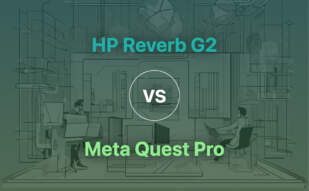Meta Quest Pro is a high-end VR headset developed by Reality Labs, a division of Meta Platforms. Featuring a Qualcomm Snapdragon XR2+ chip, 12GB RAM, and advanced controllers, it targets enthusiasts and professionals for VR and MR applications.

Alternatives to Meta Quest Pro encompass Quest 2, Quest 3, Quest Pro, Quest, Oculus, Rift S, HP Omnicept, Magic Leap 2, Magic Leap 1, Vive Pro 2, PSVR 2, Valve Index, and HoloLens 2.
Quest 2
Enter the expansive world of VR with Quest 2, a technologically superior headset brought to you by Reality Labs, a division of Meta Platforms. Rebranded as Meta Quest 2 in 2022, this device marks a new era of VR.
Quest 2 Top Features
- Advanced Display: Offering a stunning RGB LCD with 1832 x 1920 resolution per eye, refreshing at a rate of 72-120 Hz
- Immersive Audio: Built with two integrated speakers and a 3.5mm headphone jack
- Wireless Freedom: Standalone operations enabled with Android-based Quest system software
- High Connectivity: Features USB-C, Bluetooth 5, and Wi-Fi 6
- Generous Storage: Available in 128 GB and 256 GB variations
- Efficient Processor: Powered by Qualcomm SnapDragon XR2
- Precise Tracking: With 6DOF inside-out tracking via four in-built cameras and two controllers
| Important Features | Details |
|---|---|
| Design | Lightweight, with an improved display and long-lasting Oculus Touch controllers |
| Storage Upgrade | Standard 128GB offering, up from the original 64GB |
| Standard Refresh Rate | Boosted from 72Hz to an impressive 120Hz |
Quest 2 Disadvantages
- Short Battery Life: Lasts between only 2-3 hours between charges
- Limited Expansion: Storage offering has no room for expansion
Quest 2 Pricing
For the 64 GB model, beginning at $299, while the 256 GB version is priced at $399. Though competitively priced, it’s important to account for your storage needs and consider important add-ons.
Quest 2 Use Cases
Use case 1: Gaming
With the associated Quest Store housing dozens of VR games, Quest 2 is a gamer’s paradise.
Use case 2: Education
Leveraging the power of VR, teachers can create immersive, interactive learning environments with the Quest 2.
Use case 3: Professional Training
The Quest 2 can be utilised for training in various professional fields, providing a realistic simulation and real-time feedback.
Quest 3
The Quest 3 is a breakthrough mixed reality headset from Meta, offering an immersive experience with a noticeable improvement over its predecessor, the Quest 2. This gadget is powered by the Snapdragon XR2 Gen 2 platform, developed in collaboration with Qualcomm.
Quest 3 Top Features
- 30% increase in visual resolution and 40% louder audio range than Quest 2.
- Improved comfort with a redesigned, thinner profile and adjustable strap.
- 4K+ Infinite Display with a pixel density of 1,218 pixels per inch.
- Augmented reality functionality for board games like Demeo.
- Automatic guardian system enabled by new depth sensor and upgraded cameras.
- Advanced mixed reality capabilities backed by Qualcomm Snapdragon XR2 Gen 2 chipset.
| Model | Price |
|---|---|
| 128GB | $499.99 USD |
| 512GB | $649.99 USD |
Quest 3 Limitations
- Cost may be prohibitive for some users.
- Fresnel lenses in Quest 2 replaced with “pancake lenses” may have compatibility issues.
- Backwards compatible titles limited to Quest 2.
Quest 3 Pricing
The Quest 3 comes in two price variants: the 128GB model is priced at $499.99, while the more expansive 512GB model can be acquired for $649.99.
Quest 3 Use Cases
Fitness and Sports
Quest 3’s advanced capabilities make fitness training with Xponential+ and sports-viewing with Xtadium a uniquely immersive experience.
Gaming
From AR board games like Demeo to the vivid worlds of Dungeons of Eternity, the Quest 3 offers an unparalleled gaming experience.
Mixed Reality Experiences
Features like shared spatial anchors and full-color passthrough introduce new possibilities for mixed reality experiences – from decoration with “augments” to safe and easy spatial mapping.
PSVR 2
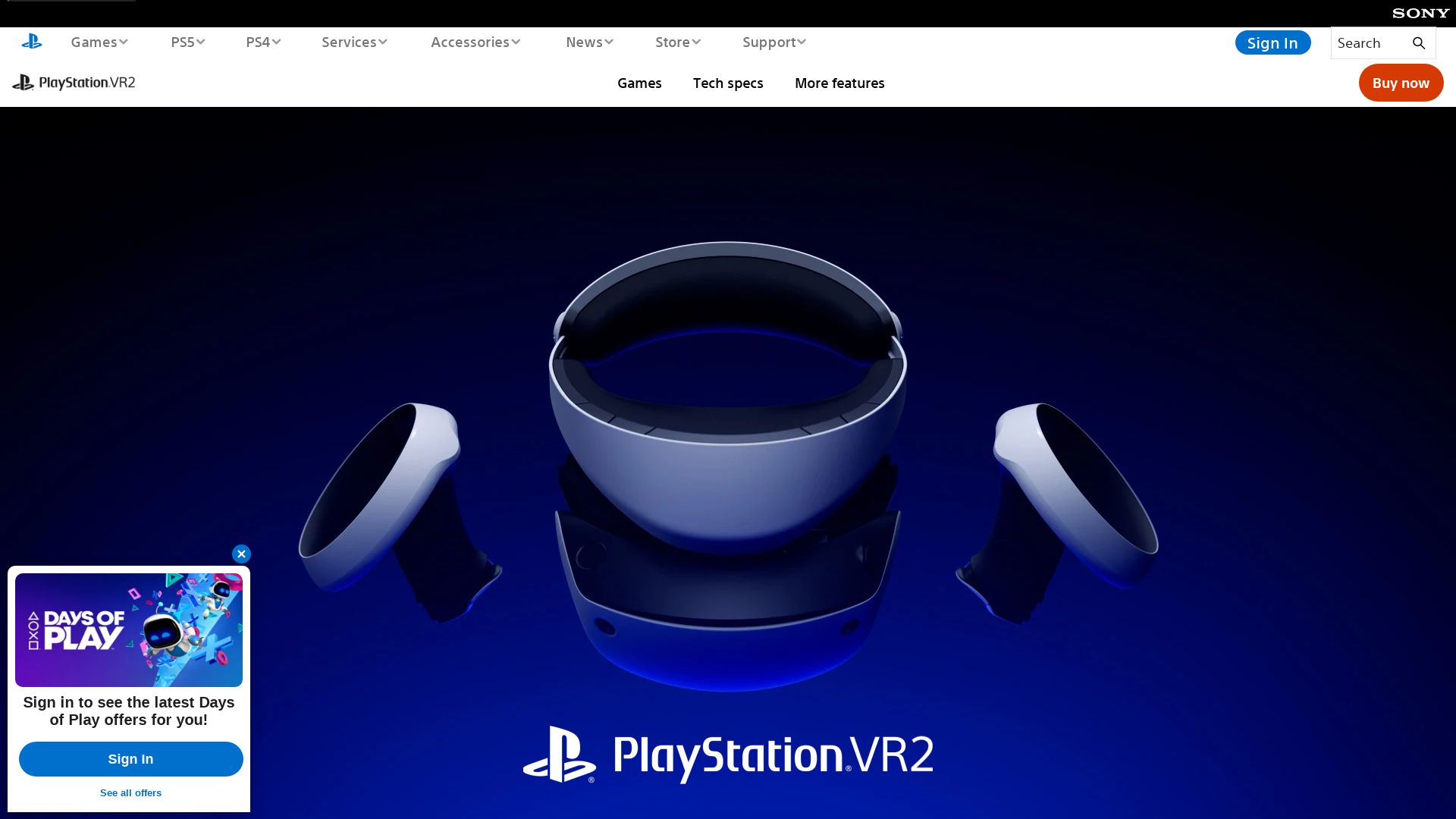
Emerging as a prominent player in the AR hardware scene is the PSVR 2 – a superior successor to the PSVR 1, requiring the PlayStation 5 as a prerequisite.
PSVR 2 Top Features
- Improved Specs: Enhanced resolution (2,000 x 2,040) over original PSVR’s 960 x 1,080 displays.
- Better Performance: Outperforms Meta Quest 2; supports up to 120Hz refresh rate, HDR for a vivid display.
- Improved Design: High comfort level with an adjustable lens module and sturdy headset; lighter and more robust Sense controllers replace old Move controllers.
| Feature | Details |
|---|---|
| Sense Controllers | Equipped with USB Type-C input, headset feedback, adaptive triggers, eye tracking. |
| Audio | Earbuds included to enhance user immersion in VR. |
| Stream to TV | Automatic streaming of VR user view for shared experiences. |
PSVR 2 Limitations
- High Price Point: Costs more than the console itself, at $549.99/£529.99; additional charges for accessories.
- Short Battery Life: High performance comes with quick battery drains.
- Limited Game Options: Not backwards compatible with previous PSVR titles; exclusive games still limited.
PSVR 2 Pricing
The price point for the PSVR 2 is $549.99/£529.99, making it a significant investment even more costly than the PlayStation 5 console itself. Accessories like the Sense Controller Charging Dock and Pulse Headset add to the overall expense.
PSVR 2 Use Cases
Use Case 1: Hardcore Gaming
The PSVR 2, with its exceptional performance and exclusive VR titles, is perfect for dedicated Sony and VR gaming enthusiasts.
Use Case 2: Immersive Entertainment
For those prioritising immersive entertainment, PSVR 2 with incisive eye-tracking and bundled earbuds offers an unparalleled VR experience.
Use Case 3: Tech Savvy Users
Tech aficionados, with an appreciation for advanced features and willing to invest in top-spec hardware, will find their match in PSVR 2.
Valve Index

A product of true innovation, the Valve Index stands tall as a second-generation, consumer virtual reality headset, cradled in the capable hands of its creator, Valve.
Valve Index Top Features
- An immersive experience is accorded courtesy of the enhanced sharpness brought by Dual 1440 x 1600 RGB LCDs, showcasing a staggering 50% more subpixels than OLED.
- Enjoy the crystal-clear delivery in motion with reduced illumination period of 0.33ms to 0.53ms.
- Comfortable play prolonged with variable frame rates of 80/90/120/144Hz.
- Superior FOV, offering an extra 20 degrees over HTC Vive, adjustable for personalization.
| Controllers | Audio |
|---|---|
| Fitted with 87 sensors for precise hand and finger tracking, inclusive of a joystick, touchpad, two face buttons, a menu button, and a trigger. | An evolutionary off-ear audio solution, crafted for diverse ear and head shapes, offering adjustability and superior comfort via ultra-nearfield flat panel speakers. |
| Tracking | External Integrations |
| The use of SteamVR 2.0 sensors enables compatibility with SteamVR 1.0 and 2.0 base stations, as well as HTC Vive and Vive Pro Controllers. | Inherently compatible with Steam as well as other available hardware agnostic. |
Valve Index Limitations
- Although abundant in advanced features, the Valve Index falls short in providing tactile feedback.
- Costs are elevated; no eye tracking available for increased user experience.
- Room-scale sensor setup can be complex and frustrating.
Valve Index Pricing
While the initial price tagged at $999, the headset alone now is priced at $799. A full kit can be obtained at $999.
Valve Index Use Cases
Use case 1
The clear and vibrant visual quality backed by dual RGB LCDs can greatly benefit graphic designers by offering an immersive work canvas.
Use case 2
The enhanced FOV of Valve Index can uplift gamers’ experience by providing a more inclusive and encompassing view to the virtual world.
Use case 3
Top-tier visual and audio quality and comfort make the Valve Index a preferred choice for educational purposes where immersive learning enhances knowledge uptake.
HoloLens 2
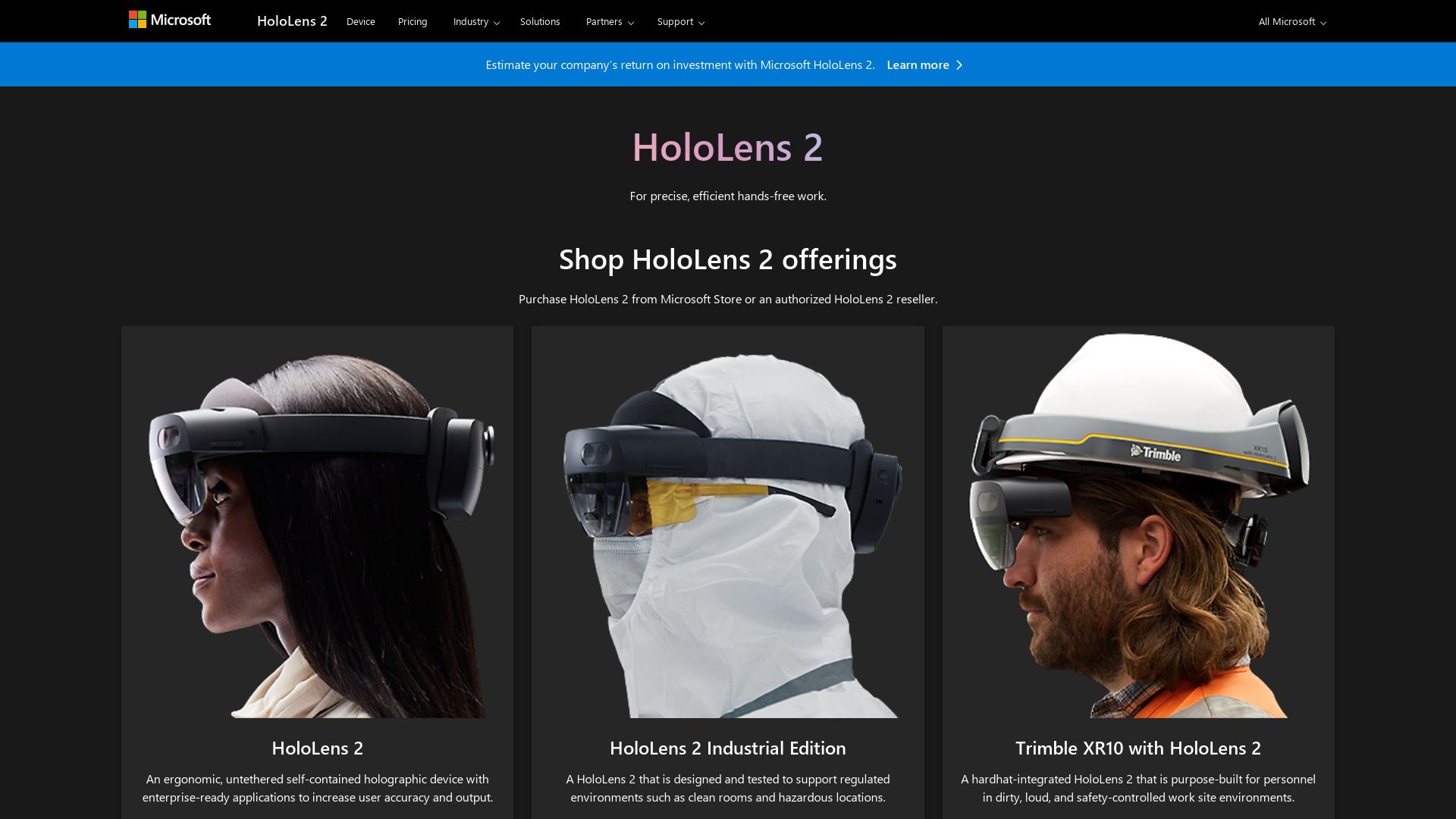
If Thomas Edison were alive today, he’d probably name the HoloLens 2 as his favorite toy. This game-changing headset by Microsoft isn’t about how many bad guys you can vaporize in virtual reality. Instead, it’s designed to give productivity and education a corny high-five with augmented reality.
HoloLens 2 Top Features
- Brings enterprise-level efficiency with the Qualcomm Snapdragon 850 processor and 64GB storage.
- Comfort and style go hand-in-hand with a visored design and a weight of 566g, which is similar to the first Oculus Quest. Mind you, those extra hours at the gym pay off!
- Eye-tracking is the new cool kid on the block, facilitated by onboard infrared cameras.
- A whopping 8MP resolution camera makes for improved human-computer interfacing & gives biometric security a thumbs up.
| Attribute | Details |
|---|---|
| Display | Brace yourselves for 1440×936 pixels per eye, all thanks to the magic of waveguide technology. |
| Sound Quality | Featuring spatial sound with a 5-mic array, making sure you sound like Morgan Freeman during voice commands. |
| Camera | A swanky 1080 30fps video capturing ability for all your panel discussion and cat-jumping-on-the-keyboard recording needs. |
HoloLens 2 Limitations
- Costs your piggy bank a whopping $3500. Now, who said money can’t buy happiness?
- Not ideal for gamers or tech enthusiasts due to minor focus on games and entertainment.
- Energy guzzler, with battery life dropping to two hours under heavy use.
HoloLens 2 Pricing
The HoloLens 2 is far from cheap, wearing a price tag of $3500. It’s a cherry-picked investment for those diving deep into the AR ocean though, and offers a fantastic ROI.
HoloLens 2 Use Cases
Enterprise Applications
Thanks to its robust hardware and software components, the HoloLens 2 is a champ for the enterprise market. It’s not just a headset, it’s a productivity powerhouse. Azure Cloud Storage has got your back!
Education
Whether you’re exploring the inside of a human body or taking a trip to ancient Greece, HoloLens 2 embarks on a journey of knowledge that’s as comfortable as it is enlightening.
Quest Pro
Quest Pro, a VR/AR headset from Meta, is designed for enterprise users with an affinity for technology-enhanced workflows. The headset is marked by its sleek design and enhanced feature set, standing as a substantial professional choice in VR/AR hardware.
Quest Pro Top Features
- Snapdragon XR2+ processor: Its processor is 50% stronger than the Quest 2, ensuring robust performance.
- Enhanced Resolution: It sports a resolution of 1,920 x 1,800 pixels per eye and a 130% larger color gamut than Quest 2.
- Diverse Features: Packed with 5 cameras (3 front-facing, 2 side-facing), two headphone jacks, and angled speakers, the Quest Pro is amply equipped for a superior user experience.
- Motion Controllers: It features redesigned, lightweight controllers with rechargeable batteries, ensuring less cumbersome usage.
| Design | Professional black glossy front panel |
| Comfort | Wraparound band with padding and optional light blocker accessory for improved comfort |
| Storage | Sizable 256GB storage |
Quest Pro Limitations
- Gauged at $1499.99, the Quest Pro cost might deter budget-conscious users.
- The headset is unpadded and might press against the face, potentially causing discomfort.
- Software limitations might limit the scope of consumer-focused applications leveraging the device’s professional-grade upgrades.
Quest Pro Pricing
The Quest Pro is priced at $1499.99, notably three times the Meta Quest 2’s price, aligning it more closely with professional users and niche consumer markets.
Quest Pro Use Cases
Use case 1
For enterprises requiring high-tech, immersive solutions for collaborative work, Quest Pro provides customized interfaces within Meta Horizon Worlds.
Use case 2
For professional users needing specific VR/AR hardware, the higher cost and feature-set including Snapdragon XR2+ processor, makes the Quest Pro a suitable choice.
Use case 3
For lifestyle meters, Quest Pro pairs well with iPhone 14 Pro/15 Pro’s ‘Standby Mode’, offering mixed reality capabilities.
Quest
Embark on a journey into virtual reality with Quest, a VR headset developed by Oculus that is part of the Meta family, erstwhile Facebook. Quest is the fourth consumer VR headset from Oculus, quickly earning its place in the mainstream due to its standalone design and a powerful repertoire of features.
Quest Top Features
- Standalone design: Freeing you from the constraints of cables and compatible devices, Quest doesn’t connect to a phone or PC.
- High-resolution display: Offers a vivid visual experience with a resolution of 1600 x 1440 pixels per eye.
- Snapdragon XR2 processor: Derived from Snapdragon 865, powers immersive gaming and experiences.
- Unique controller design: Flip the tracking strip from below to above your hands for headset cameras. Supports hand tracking for select games.
- Wireless capability: Experience the freedom of movement, thanks to its completely wireless design that doesn’t require a gaming PC.
| Feature | Description |
|---|---|
| Storage options | Offers 64GB, 128GB, or increased 256GB storage for massive game libraries. |
| Battery life | Supports gaming sessions of two to three hours with optimal charging. |
| Compatible content | Compatible with 500+ VR games and experiences, positioning it as a heavyweight champion of immersive tech. |
Quest Limitations
- Requires accessory for advanced experiences: To access more graphically advanced VR experiences, an optional accessory cable for PC tethering is needed.
- Short battery life: The battery life lasts between two to three hours, which limits prolonged usage.
- Outdated chipset: Quest uses the Qualcomm Snapdragon 835 mobile chipset from 2017, which may limit its performance compared to newer models.
Quest Pricing
The 128GB variant of Quest launched at a price of $399.99. The Meta Quest 3, a subsequent model set to launch in Fall 2023, is priced at $499.99. Additional storage options are available at an extra cost.
Quest Use Cases
Use Case 1: Gaming
With the support of popular VR gaming experiences like Beat Saber, The Climb, and Robo Recall, Quest is a haven for gamers craving immersive adventures.
Use Case 2: Content Creation
For content creators, Quest offers the opportunity to experiment with high-fidelity color Passthrough and innovative machine learning for spatial understanding.
Use Case 3: Casual Users
For casual users looking for an escape, Quest’s vast array of VR experiences can provide the perfect respite from reality, all in the comfort of their living room.
Oculus
In the realm of virtual reality, Oculus stands as a industry pioneer, founded by Palmer Luckey and later acquired by Facebook. Notably, their Oculus Rift revolutionized the VR landscape by offering an immersive, high-quality experience at a surprisingly affordable price.
Top Oculus Features
- Immersive 90 degrees horizontal and 110 degrees vertical stereoscopic 3D view.
- Utilization of three-axis gyros, accelerometers, and magnetometers for precise head orientation tracking.
- Resolution of 1280×800, effectively 640×800 per eye, significantly reducing the screen door effect.
| Feature | Description |
|---|---|
| Prototype Features | Geometric pre-distortion, large stereoscopic field-of-view |
| LCD Panel | Improved clarity and reduced screen door effect with 1080p resolution |
Oculus Limitations
- Discontinued the Oculus Rift line in 2021, limiting future developments.
- Successor, Oculus Quest, might have compatibility issues with certain software titles.
Oculus Pricing
While the price for Oculus devices may vary due to model and specs, they have historically been heralded for their cost-effective nature.
Oculus Use Cases
Use case 1
Oculus is a potent tool for gaming enthusiasts, providing an immersive experience that makes users feel genuinely part of the game world.
Use case 2
Oculus headsets find applicability in professional training simulations, improving productivity and efficiency in a risk-free virtual environment.
Use case 3
Oculus VR technology wonderfully serves interactive fitness or therapeutic app development, further blurring the lines between the physical and the digital.
Rift S
A product of the synergistic efforts of Facebook Technologies and Lenovo, the Rift S is a force to reckon with in the VR industry. Launched in March 2019, it’s an enhanced version of the original Oculus Rift that comes with a promise of immersive gaming using Oculus Insight tracking technology.
Rift S Top Features
- Improved “inside-out” positional tracking system, making it an incremental upgrade over its predecessor.
- High-resolution display of 2560×1440 (1280×1440 per eye) at 80Hz refresh rate with reduced screen door effect.
- Advanced lens tech eliminates god rays, providing an unrivalled field of view of 115°.
- Passthrough+ feature included for user safety, enabling monochrome visuals of surroundings when boundaries are breached.
| Platform Compatibility | Oculus Store, Viveport store, Steam VR |
| Weight | 1.1 lb without cable |
Rift S Limitations
- A mixed bag of reviews, criticized for being only an incremental upgrade rather than a revolutionary improvement.
- Limited adjustable IPD via software using single screen.
Rift S Pricing
Available at a price of $399 at its launch, the Rift S offered value-rich features and improvements over the original Oculus Rift.
Rift S Use Cases
Use Case 1: High-End Gaming
With Oculus Insight tracking technology offering immersive gaming experiences, the Rift S surpasses its sibling Oculus Quest in supporting high-end Oculus games.
Use Case 2: Improved VR Sessions
The headset’s Lenovo-designed halo headband offers superior comfort by optimizing weight distribution, allowing for extended VR sessions without discomfort.
Use Case 3: Realistic Interactions
Using its Insight system and LCD panel tech, every interaction is smoother and sharper, adding a touch of realism to VR sessions.
HP Omnicept
Awaken to a splendid blend of sensory finesse and analytical insight, powered by HP’s Omnicept. Recognized as an enterprise-focused VR headset, the Omnicept marries the functionality of the Reverb G2 headset with technological upgrades. Diving into empathetic design, HP respects user privacy, ensuring sensor data isn’t stored on the headset and complies with GDPR regulations.
HP Omnicept Best Features
- Immersive 2160×2160 pixels resolution per eye (4.7MP) and a refresh rate of 90Hz
- Strategic sensor installation for eye, mouth, and heartbeat tracking
- Superior extendibility with USB-C, DisplayPort, and Power connectors, supported by a 6m tracking cable
- Bundled with a Software Development Kit (SDK) and an Independent Software Vendor (ISV) network for businesses to build VR solutions efficiently
- Bolstered with robust pupillometry API, eye-tracking API, Lower Face Camera API, Heart Rate API with advanced features for the enterprise tier
| Height, width, volume, and camera count | Surpass industry average |
| Built-in features | Off-ear headphones, microphone, pass-through cameras, adjustable lenses, 3D spatial audio, and camera for real-time facial animation |
| Platform | Snapdragon XR2 Gen 2 platform for 2x faster graphics |
HP Omnicept Disadvantages
- Requires developers to share 2% revenue for profit-based applications
- Features like Pulse Rate Variability API are available only on the higher-priced Enterprise tier
- Software deployment cost is chargeable with one-time licenses for in-house solutions
HP Omnicept Pricing
Envisioned for the enterprising spirits, the HP Omnicept opens its treasure trove at $1,250. This price tag serves as the gateway to its immersive sensory realm, ensuring a future full of innovative applications.
HP Omnicept Use Cases
Use Case 1: Enterprise Training
HP Omnicept’s precise sensor integration along with robust APIs make it a potent tool for immersive and interactive employee training experiences.
Use Case 2: Collaborative Creation
Embracing the solidarity of creation, HP Omnicept fuels co-creation and collaboration amongst enterprises by fostering lifelike interactions in a digitally reimagined world.
Use Case 3: Well-being
Emerging as a companion to holistic wellness, HP Omnicept uses biometrics to analyze cognitive load, offering unique possibilities for stress management and well-being applications.
Magic Leap 2

Ready to enjoy the magic of cutting-edge Augmented Reality (AR)? Look no further than Magic Leap 2, an enterprise-level AR device tirelessly crafted after a whopping 1,500 face scans, and loaded with the power of AMD quad-core Zen 2 SoC chip for a smooth, immersive experience!
Top Magic Leap 2 Features
- Constructed after meticulously analyzing 1,500 faces — so it’s practically semi-bespoke!
- Dynamic Dimming technology assures use in varying light conditions
- Enjoy all-day comfort with a light-as-a-feather weight of 260g (That’s just like an extra pair of headphones!)
- Fitted with industry-leading optics of 32-layers in the lens for crystal-clear visuals
- Eye strain from extensive usage? Not on Magic Leap 2’s watch! Four eye-tracking cameras adjust rendering accordingly
| Feature | Description |
|---|---|
| AMD quad-core Zen 2 SoC chip | Supports high-demand visuals and apps |
| Resolution 1440×1760 px | Ensures image and text clarity par excellence |
| Seamless integration with MDM systems | For smoother management and operations |
Magic Leap 2 Downsides
- At starting price of USD $3,692.99, it might feel a pinch for budget-conscious consumers
- Despite the light weight, wearing any device over an extended period could cause discomfort
Magic Leap 2 Pricing
With a price tag of USD $3,692.99, Magic Leap 2 is definitely more of a business investment than a casual AR pickup. But with its impressive lineup of features, it promises to pack a big bang for every buck.
Magic Leap 2 Use Cases
Use case 1 — Enterprise Collaboration
With features like robust spatial audio and FOV for extensive collaboration, Magic Leap 2 makes virtual meetings more real and productive than ever. It’s like being in the same room sans the passive-aggressive boardroom vibes.
Use case 2 — Glasses wearers
Frequent glasses wearer? No worries! Magic Leap 2 includes Prescription Inserts that can be swapped out quickly. So now you can navigate the AR world hassle-free, without straining your eyes.
Use case 3 — Content Creators and Developers
With a powerful Zen 2 SoC chip, a lens with 32 layers, and a 1440×1760 px resolution, Magic Leap 2 provides a promising platform for content creators and developers. Here’s your chance to create stunning AR experiences that users will lose and find themselves in!
Magic Leap 1
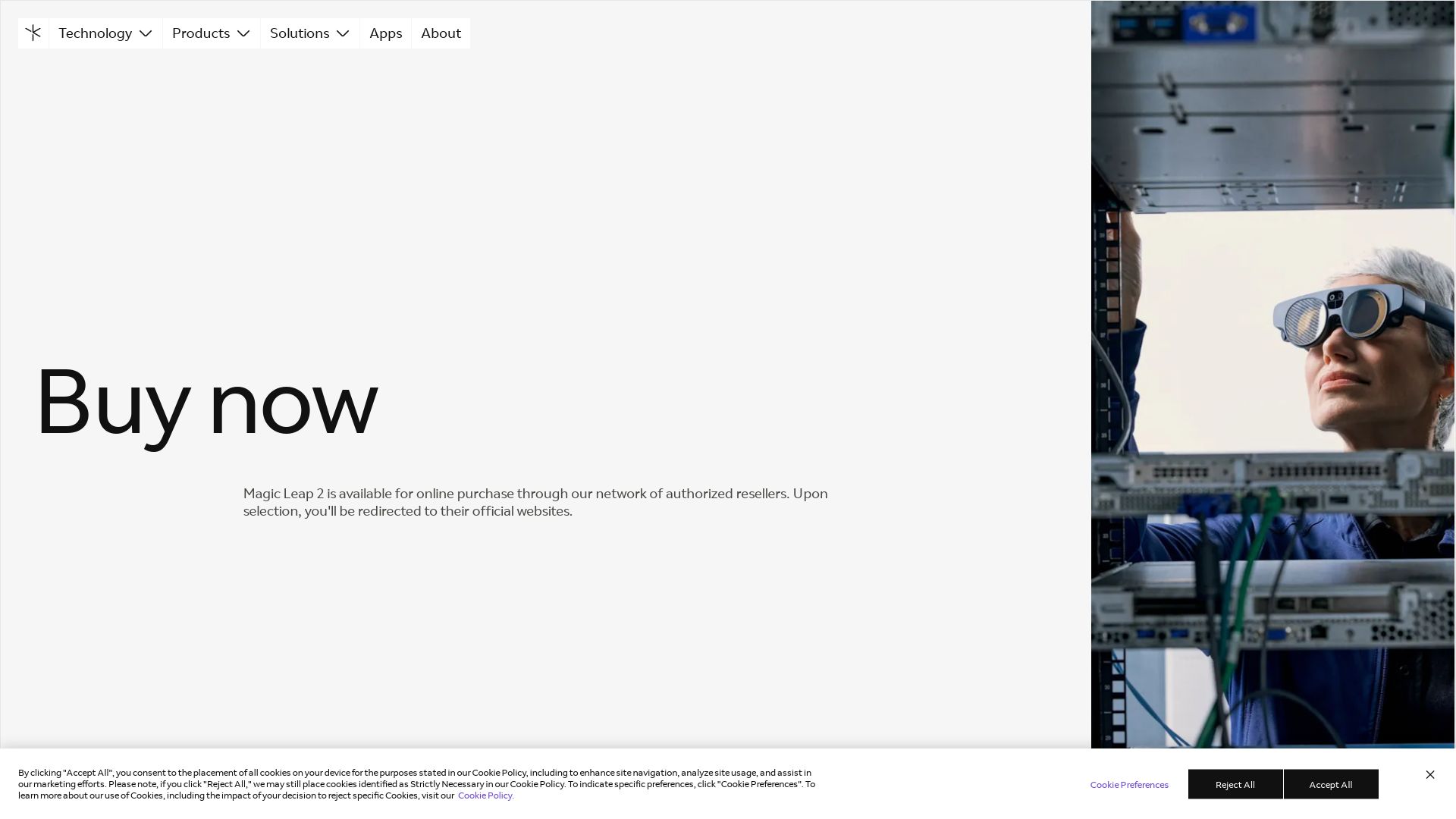
An innovative AR system from the corridors of American tech pioneer Magic Leap, the Magic Leap 1 integrates cutting-edge AR and mixed reality, shaping a revolutionary computing outlook.
Best Features of Magic Leap 1
- Lightwear Headset: A wearable tech marvel connecting to Lightpack, a wearable computer device featuring Nvidia Tegra X2 chipset, empowering your mixed reality vision with a hologram-like 3D experience.
- Mighty Internals: Flaunting a solid 8GB memory and generous 128GB storage, it operates on an enduring battery offering up to three hours of usage.
- Advanced Tracking: Boasting environment tracking and eye-tracking cameras, enabling a seamless AR experience.
| Feature | Details |
|---|---|
| Wi-Fi & Bluetooth | No mobile data? No worries! Magic Leap 1 comes equipped with Wi-Fi and Bluetooth sans mobile data options. |
| Field of View | 50% larger than Microsoft’s HoloLens, making the magical realm more realistic. |
| Lumen OS | A Linux-based system with floating balls interface, transports you to an immersive digital environment powered with a set of diverse apps and functionalities. |
Magic Leap 1 Drawbacks
- Limited field of view projects images only into a moderately sized rectangle.
- Visualization hiccups with glowing edges, slight transparency, occasional shifting, or jittering of objects.
- Primarily designed for indoor usage, its portability and adaptability take a hit.
Magic Leap 1 Use Cases
Entertainment
Experience the future of entertainment with NBA mixed reality app preview, transforming your living room into an NBA court.
Art and Design
Embrace the blend of art and tech with Magic Leap’s art app that allows you to paint your imagination in mid-air.
Interactive Music
Dive into exclusive musical experiences with Tonandi, bringing to life an interactive landscape unfolding to the music’s tempo.
Vive Pro 2
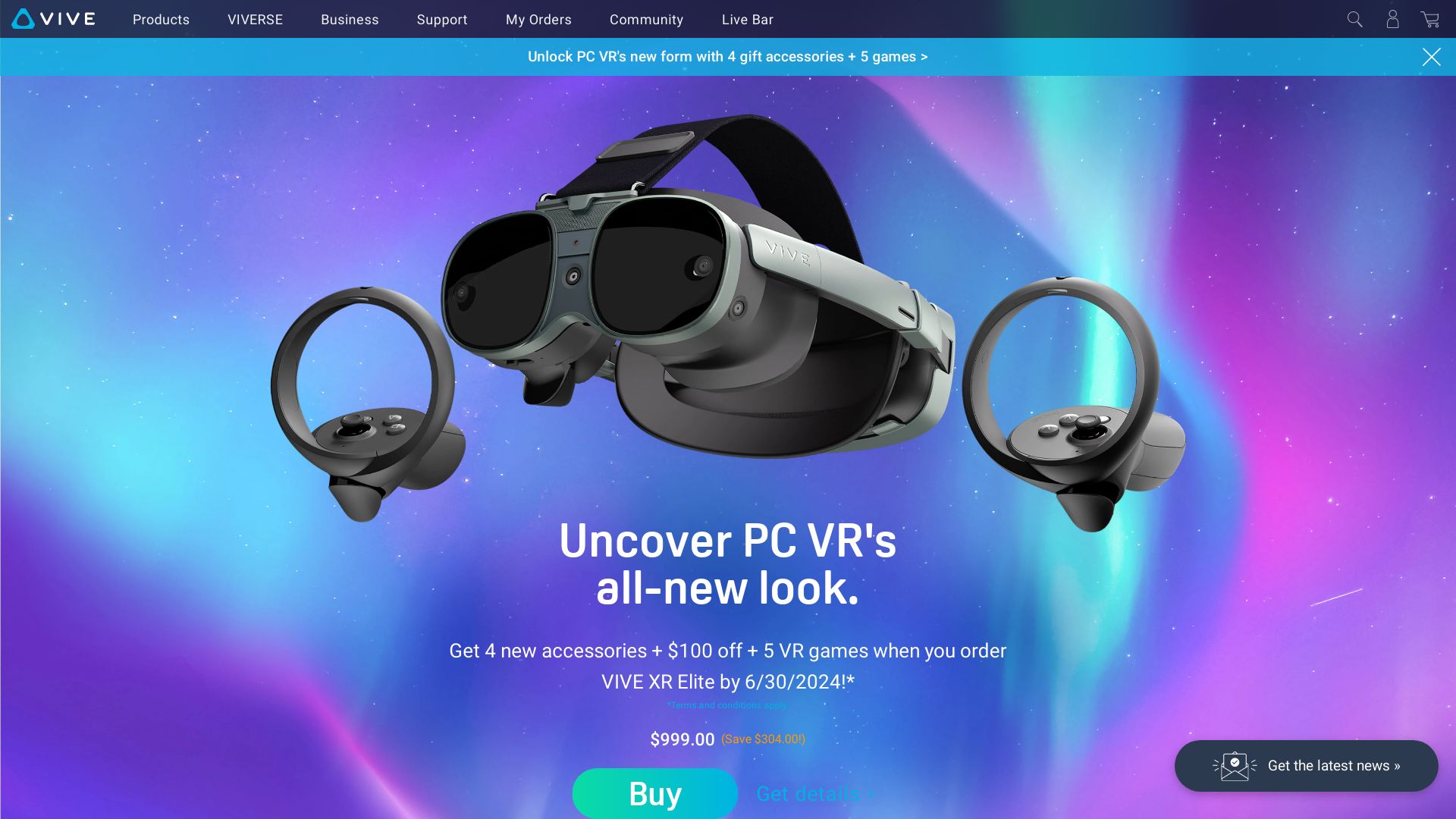
Step into the vibrant, detail-packed digital world with Vive Pro 2, a sharp and immersive AR/VR headset that comes bundled with a two-month Viveport Infinity membership.
Vive Pro 2 Top Features
- Quality 3D Graphics: With three.js, achieve cross-browser JavaScript library API for sophisticated animated 3D graphics.
- WebGL 2.0: Default use of WebGL 2.0 allows for accelerated GPU rendering of 3D animations, with continued support for older versions through WebGL1Renderer class.
- Rich Animations: Presents a broad variety of animations such as armatures, forward kinematic, morph, and keyframe animations.
- Extensive Community: Over 1700 contributors on GitHub and a public online forum for collaborating and problem-solving.
- Light and Material Effects: Wide array of light effects and different materials like Lambert, Phong, smooth shading, textures.
| Framework Origin | Launched in April 2010 by Ricardo Cabello after his substantial involvement in the Demoscene. |
| Languages | Originally developed in ActionScript, then ported to JavaScript with additional contributions from developers worldwide. |
| Coding Examples | Over 150 coding examples provided to guide users. |
Vive Pro 2 Disadvantages
- API Documentation: Currently under construction, necessitating independent learning for some users.
Vive Pro 2 Use Cases
Use case 1
For 3D animators and designers: Use Vive Pro 2’s three.js feature to create high-quality 3D animations with multiple effects. Its support for WebGL 2.0 makes it a compatible tool for modern design workflows.
Use case 2
For game developers: Utilize Vive Pro 2’s array of animation perspectives, light effects, and different materials to deliver an immersive gaming experience.
Use case 3
For educational settings: Using Vive Pro 2, educators can develop rich, interactive materials, utilizing 3D graphics for enhanced learning experiences.
Hannah Stewart
Content writer @ Aircada, tech enthusiast, metaverse explorer, and coffee addict. Weaving stories in digital realms.



